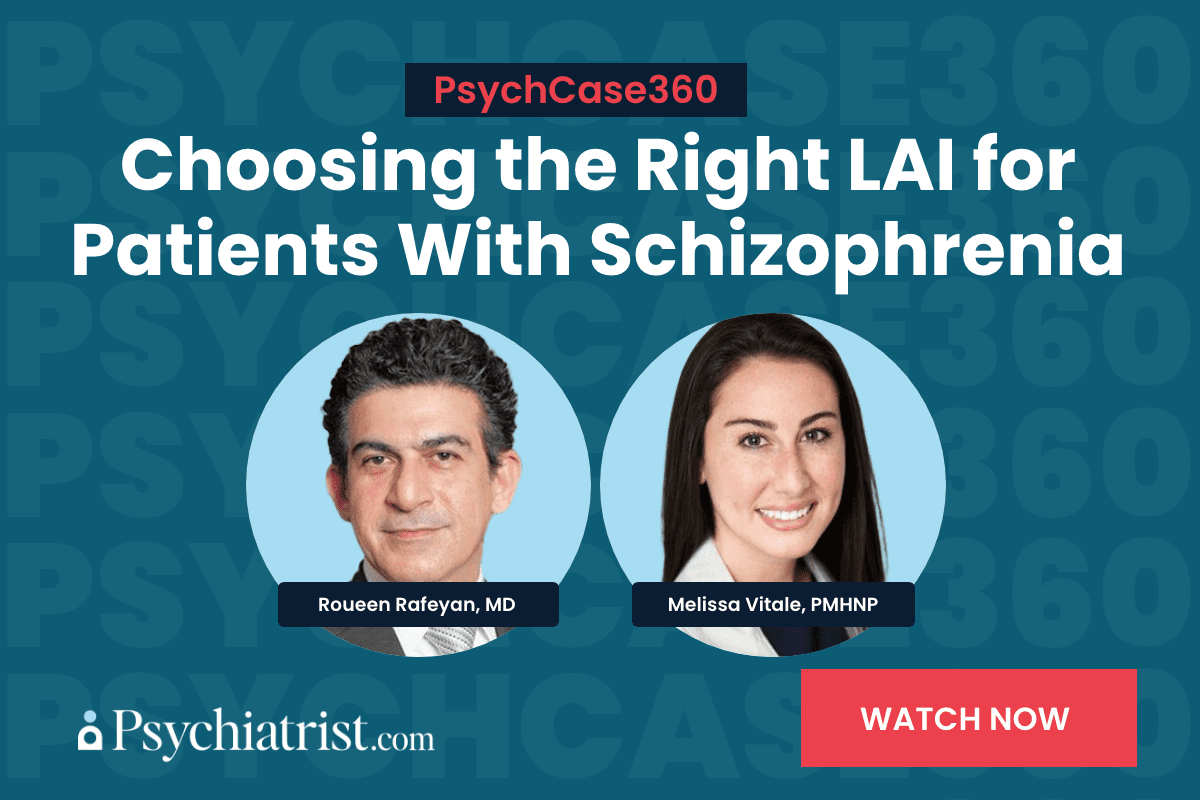See article by Hsu et al
Our field’s understanding about the limitations of psychiatric diagnosis is well established and continues to grow and evolve. The DSM-5, while still considered the standard of care in clinical practice, has been subjected to much debate and controversy. Common criticisms, among many, include potential subjectivity of raters and symptomatic overlap between different conditions (eg, depression overlapping with anxiety).1–3 Furthermore, DSM-5 often provides broad and unwieldy representations of the different disorders. For example, major depressive disorder could theoretically present in 227 different ways based on combinations of 5 of the 9 key DSM-5 symptoms, and this expands to at least 4,767 configurations when considering other factors such as severity and course modifiers.4 With such a vast range of presentations, it is not unreasonable to suppose that there could be underlying qualitative—specifically, biological—differences between patients presenting with different symptom clusters: for example, a depressed individual with a melancholic symptom profile vs one with atypical symptoms.5 Similar considerations apply to bipolar disorder, the diagnosis of which also involves selection from an array of symptoms.
It is therefore not surprising that various technologies and biological assays are being pursued with the goal of more accurate diagnosis of mood disorders, based on objective rather than subjective data.5 In the past two decades, there have been increasing numbers of investigations seeking the “ultimate biomarker(s)” of depression and other psychiatric disorders.6,7 Common approaches include studies of genetics,8 neuroimaging,9 inflammatory biomarkers,10 neurotransmitter metabolites,11 data from wearable devices,12 and other strategies seeking a definitive marker of depression, or more realistically, different biomarker configurations that may identify different subtypes of depression.13 Such diagnostic methods could potentially prove more reliable, particularly regarding selection of appropriate treatments for certain mood disorder subtypes. Biological markers of different sorts therefore represent a great hope for our field and for the millions of people worldwide who suffer from mood disorders.
Appetite hormones have been proposed as factors in the development of major mood disorders and are the topic of this issue’s interesting report by Hsu and colleagues.14 In this investigation, the authors examined whether profiles of appetite hormones presented a biotype that could help identify different kinds of patients with major affective disorders. The authors recruited 501 subjects, with bipolar disorder and major depressive disorder represented approximately equally, and examined their fasting levels of 3 key appetite-related hormones: insulin, leptin, and adiponectin. In addition to assessing inflammatory biomarker levels, subjects underwent the Wisconsin Card Sorting Test (WCST) to assess characteristics such as strategic planning, searching, environmental feedback use to shift cognitive sets, goal-directed behavior, and impulse control. Based on the findings, the authors identified 3 potential biotype groups: (1) high insulin/leptin and low adiponectin; (2) low insulin/leptin and high adiponectin; and (3) an intermediate group. The group exhibiting high insulin and leptin and low adiponectin demonstrated a poorer performance on the WCST, as well as higher C-reactive protein (CRP) and tumor necrosis factor-alpha (TNF-α) levels compared to the other biotypes. This suggests a potential role for these hormones in the characterization of different mood related biotypes. The report adds to the large and growing body of work investigating biomarkers of mood disorders and may have implications for the development and selection of treatments for these disorders.
Investigations of this kind could help pave the way for personalized treatment strategies more effective than current approaches based primarily on clinical observations. For example, it is still common to recommend tricyclic antidepressants to patients with melancholic depression, and monoamine oxidase inhibitors to those with atypical depression, even though evidence for these strategies is not conclusive.15,16 Biomarker profiles could more accurately characterize patients that may be more likely or less likely to respond to a particular treatment. Such an approach could potentially reduce the frequency of failed treatments and expedite the implementation of appropriate therapies.
Yet despite many promising findings, psychiatric treatment remains largely a process of trial and error.17,18,19 Psychiatrists who treat mood disorders generally recommend antidepressants, mood stabilizers, particularly if bipolar disorder is present, psychotherapy, or a combination of medication and psychotherapy. Clinicians and patients must then choose from ample therapeutic options within those categories. There are now approximately 40 registered antidepressants on the market,20 and psychotherapies have evolved to a point where there are specialized forms that may be applied, for example, to depressed individuals who also struggle with substance use disorders21 or the effects of traumatic brain injury,22 among others.23 A more streamlined and precise system for treatment selection would be impactful. For example, patients with elevated inflammation measured by CRP may respond less well to standard antidepressants but better to anti-inflammatory treatments, including anti-inflammatory drugs or dietary changes to reduce inflammation.24 Similarly, our recent investigations on omega-3 fatty acids for depression have targeted individuals who were overweight and had elevated inflammatory markers, since earlier work suggested that these patients responded better to omega 3.25,26 Investigations of this sort, if successful and reproducible on a large scale, could eventually lead to more targeted, individualized treatments for mood disorders administered in a more expeditious manner than what our current approaches can accomplish.
Along the same lines, biomarker monitoring could also help characterize treatment response patterns, including response, remission, and relapse or recurrence, again reducing the dependence on subjective reports from patients.27 This could be particularly helpful in settings where there is a language barrier or culturally based obstacles to effective clinician-patient communication. Finally, routine testing for some of these biomarkers, where cost effective, could lead to better prevention strategies for these mood disorders, an area that remains largely understudied and mysterious.6,28
The immediate future, however, is not so promising. Most biomarkers suffer from a lack of specificity with regard to matching to the disorders of interest.29,30 Also, mood disorders are thought to have multifactorial, interacting causes. For example, many genes31 and inflammatory markers32 have been associated with depression. With so many known biomarkers, and more being discovered, characterization of mood disorders becomes increasingly complicated, though these markers may eventually provide a more complete picture of mood disorders and appropriate selection of treatment.
Nowadays, many psychiatric patients seek out commercially available pharmacogenomic testing profiles that, by identifying polymorphisms of enzymes involved in drug metabolism, seek to give a sense of whether specific psychotropic medications may or may not be effective and/or well tolerated.33 These profiles typically organize the relevant medications into categories such as “red light” (avoid due to probable inefficacy and/or poor tolerability), “yellow light” (may be used, but may not be optimal), and “green light” (optimal choices). For example, methylene tetrahydrofolate reductase (MTHFR) polymorphisms have been associated with dampened folate metabolism and lower levels of active folate forms, which could render an individual more vulnerable to depression.34 Such a finding in a pharmacogenomic profile could lead to immediate supplementation with folic acid, as in the form of Deplin (5-methyltetrahydro folate; 5-MTHF), which could in turn alleviate the patient’s depression.
Other identified polymorphisms, however, may be more difficult to assess in terms of their true clinical relevance. Many individuals may demonstrate anomalies in at least some of these enzymes, but whether these polymorphisms have tangible clinical effects that may promote depression or reduce response to treatment, remains unclear.33 Some studies suggest modest improvements in treatment outcomes with implementation of pharmacogenomic profiling but others do not,35,36 and the cost-effectiveness of these profiles is also an issue. In my own clinical experience, and in that of many colleagues, some patients with treatment-resistant mood disorders have purchased these profiles (which often require out of pocket payment and may therefore not be accessible to many people) after having tried many medications without success. The medications that they tried without benefit generally fell across the spectrum in the “red,” “yellow,” and “green” categories. From a practical standpoint, these profiles did not significantly impact on our medication recommendations or accelerate successful outcomes.
Thus, we are still in the age of hit and miss. Psychopharmacologists generally begin treatment of depression with selective serotonin reuptake inhibitors, and if those do not work, they move on to serotonin norepinephrine reuptake inhibitors or bupropion or newer agents, or try combinations or augmentation (eg, with atypical antipsychotics), and hope that 1 of the approaches will “stick to the wall” and work. The biological tests discussed here still have a way to go before having a significant impact on clinical decision making. In my practice, I emphasize to the patient that psychopharmacology is largely a game of chance and a matter of hitting the right receptor or combination of receptors in the brain, and this may require multiple attempts over time. As such, a strong clinician-patient relationship is critical for maintaining patient engagement in psychopharmacologic care so that they will remain hopeful and optimistic and persevere in continuing to try medications until the right one is found. Ultimately, it is this capacity for human empathy and intuition that keeps us ahead of artificial intelligence and biological tests that have demonstrated their own inherent limitations.
Article Information
Published Online: April 9, 2025. https://doi.org/10.4088/JCP.25com15802
© 2025 Physicians Postgraduate Press, Inc.
J Clin Psychiatry 2025;86(2):25com15802
Submitted: January 20, 2025; accepted January 21, 2025.
To Cite: Mischoulon D. Investigation of appetite hormones and their association with mood disorders illustrates the current limitations of psychiatric diagnosis. J Clin Psychiatry 2025;86(2):25com15802
Author Affiliations: Depression Clinical and Research Program, Massachusetts General Hospital, Harvard Medical School, Boston, Massachusetts.
Corresponding Author: David Mischoulon, MD, PhD, Depression Clinical and Research Program, Massachusetts General Hospital, Harvard Medical School, 1 Bowdoin Sq, 6th Floor, Boston, MA 02114 ([email protected]).
Relevant Financial Relationships: Dr Mischoulon has received research support from Nordic Naturals and Heckel Medizintechnik GmbH and honoraria for speaking from the Massachusetts General Hospital Psychiatry Academy. He also works with the MGH Clinical Trials Network and Institute (CTNI), which has received research funding from multiple pharmaceutical companies and National Institute of Mental Health.
Funding/Support: None.
References (36)

- Pickersgill MD. Debating DSM-5: diagnosis and the sociology of critique. J Med Ethics. 2014;40(8):521–525. PubMed CrossRef
- Kuhl EA, Kupfer DJ, Regier DA. Patient-centered revisions to the DSM-5. Virtual Mentor. 2011;13(12):873–879.
- Wakefield JC. DSM-5, psychiatric epidemiology and the false positives problem. Epidemiol Psychiatr Sci. 2015;24(3):188–196. PubMed CrossRef
- Clem T. The Act of Diagnosis. Accessed January 11, 2025. https://tim-clem.com/diagnosis/
- Lv X, Si T, Wang G, et al. The establishment of the objective diagnostic markers and personalized medical intervention in patients with major depressive disorder: rationale and protocol. BMC Psychiatry. 2016;16:240. PubMed CrossRef
- Malik S, Singh R, Arora G, et al. Biomarkers of major depressive disorder: knowing is half the battle. Clin Psychopharmacol Neurosci. 2021;19(1):12–25. CrossRef
- Hacimusalar Y, Eşel E. Suggested biomarkers for major depressive disorder. Noro Psikiyatr Ars. 2018;55(3):280–290.
- Gururajan A, Clarke G, Dinan TG, et al. Molecular biomarkers of depression. Neurosci Biobehav Rev. 2016;64:101–133. CrossRef
- Nazarova A, Schmidt M, Cookey J, et al. Neural markers of familial risk for depression - a systematic review. Dev Cogn Neurosci. 2022;58:101161. CrossRef
- Harsanyi S, Kupcova I, Danisovic L, et al. Selected biomarkers of depression: what are the effects of cytokines and inflammation? Int J Mol Sci. 2022;24(1):578. CrossRef
- F Guerreiro Costa LN, Carneiro BA, Alves GS, et al. Metabolomics of major depressive disorder: a systematic review of clinical studies. Cureus. 2022;14(3):e23009.
- Pedrelli P, Fedor S, Ghandeharioun A, et al. Monitoring changes in depression severity using wearable and mobile sensors. Front Psychiatry. 2020;11:584711.
- Jentsch MC, Van Buel EM, Bosker FJ, et al. Biomarker approaches in major depressive disorder evaluated in the context of current hypotheses. Biomark Med. 2015;9(3):277–297. PubMed CrossRef
- Hsu JW, Lin WC, Bai YM, et al. Appetite hormone regulation biotypes of major affective disorders in proinflammatory cytokines and executive function. J Clin Psychiatry. 2025;86(2):24m15561.
- Perry PJ. Pharmacotherapy for major depression with melancholic features: relative efficacy of tricyclic versus selective serotonin reuptake inhibitor antidepressants. J Affect Disord. 1996;39(1):1–6. PubMed CrossRef
- Murck H. Atypical depression spectrum disorder - neurobiology and treatment. Acta Neuropsychiatr. 2003;15(4):227–241. PubMed CrossRef
- Goldberg JF, Freeman MP, Balon R, et al. The American Society Of Clinical Psychopharmacology Survey Of Psychopharmacologists’ practice patterns for the treatment of mood disorders. Depress Anxiety. 2015;32(8):605–613. CrossRef
- Simon GE, Perlis RH. Personalized medicine for depression: can we match patients with treatments? Am J Psychiatry. 2010;167(12):1445–1455. PubMed CrossRef
- Arnow BA, Blasey C, Williams LM, et al. Depression subtypes in predicting antidepressant response: a report from the iSPOT-D trial. Am J Psychiatry. 2015;172(8):743–750. CrossRef
- Wikipedia. List of Antidepressants. Accessed January 11, 2025. https://en.wikipedia.org/wiki/List_of_antidepressants
- McHugh RK, Hearon BA, Otto MW. Cognitive behavioral therapy for substance use disorders. Psychiatr Clin North Am. 2010;33(3):511–525. CrossRef
- Mollica A, Dey A, Neuropsychiatric treatment for mild traumatic brain injury: nonpharmacological approaches. Semin Neurol. 2022;42(2):168–181. CrossRef
- Lutz W, Vehlen A, Schwartz B. Data-informed psychological therapy, measurement-based care, and precision mental health. J Consult Clin Psychol. 2024;92(10):671–673. CrossRef
- Allison DJ, Sharma B, Timmons BW. The efficacy of anti-inflammatory treatment interventions on depression in individuals with major depressive disorder and high levels of inflammation: a systematic review of randomized clinical trials. Physiol Behav. 2019;207:104–112. PubMed CrossRef
- Mischoulon D, Dunlop BW, Kinkead B, et al. Omega-3 fatty acids for major depressive disorder with high inflammation: a randomized dose-finding clinical trial. J Clin Psychiatry. 2022;83(5):21m14074.
- Rapaport MH, Nierenberg AA, Schettler PJ, et al. Inflammation as a predictive biomarker for response to omega-3 fatty acids in major depressive disorder: a proof-of-concept study. Mol Psychiatry. 2016;21(1):71–79. PubMed CrossRef
- Thase ME. Using biomarkers to predict treatment response in major depressive disorder: evidence from past and present studies. Dialogues Clin Neurosci. 2014;16(4):539–544. PubMed CrossRef
- Kennis M, Gerritsen L, van Dalen M, et al. Prospective biomarkers of major depressive disorder: a systematic review and meta-analysis. Mol Psychiatry. 2020;25(2):321–338. PubMed CrossRef
- Jha MK, Minhajuddin A, Gadad BS, et al. Can C-reactive protein inform antidepressant medication selection in depressed outpatients? Findings from the CO-MED trial. Psychoneuroendocrinology. 2017;78:105–113. PubMed CrossRef
- Orsolini L, Pompili S, Tempia Valenta S, et al. C-reactive protein as a biomarker for major depressive disorder? Int J Mol Sci. 2022;23(3):1616. CrossRef
- Alshaya DS. Genetic and epigenetic factors associated with depression: an updated overview. Saudi J Biol Sci. 2022;29(8):103311. CrossRef
- Li JM, Jiang CL. Biological diagnosis of depression: a biomarker panel from several nonspecial indicators instead of the specific biomarker(s). Neuropsychiatr Dis Treat. 2022;18:3067–3071. CrossRef
- Barlati S, Minelli A, Nibbio G, et al. The role of pharmacogenetics in the treatment of major depressive disorder: a critical review. Front Psychiatry. 2023;14:1307473.
- Gao S, Khalid A, Amini-Salehi E, et al. Folate supplementation as a beneficial add-on treatment in relieving depressive symptoms: a meta-analysis of meta-analyses. Food Sci Nutr. 2024;12(6):3806–3818. CrossRef
- Greden JF, Parikh SV, Rothschild AJ, et al. Impact of pharmacogenomics on clinical outcomes in major depressive disorder in the GUIDED trial: a large, patient- and rater-blinded, randomized, controlled study. J Psychiatr Res. 2019;111:59–67. PubMed CrossRef
- Rosenblat JD, Lee Y, McIntyre RS. Does pharmacogenomic testing improve clinical outcomes for major depressive disorder? A systematic review of clinical trials and cost-effectiveness studies. J Clin Psychiatry. 2017;78(6):720–729.
This PDF is free for all visitors!
Save
Cite



